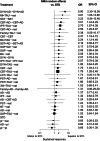Initial treatment choices to achieve sustained response in major depression: a systematic review and network meta-analysis
- PMID: 34505365
- PMCID: PMC8429344
- DOI: 10.1002/wps.20906
Initial treatment choices to achieve sustained response in major depression: a systematic review and network meta-analysis
Abstract
Major depression is often a relapsing disorder. It is therefore important to start its treatment with therapies that maximize the chance of not only getting the patients well but also keeping them well. We examined the associations between initial treatments and sustained response by conducting a network meta-analysis of randomized controlled trials (RCTs) in which adult patients with major depression were randomized to acute treatment with a psychotherapy (PSY), a protocolized antidepressant pharmacotherapy (PHA), their combination (COM), standard treatment in primary or secondary care (STD), or pill placebo, and were then followed up through a maintenance phase. By design, acute phase treatment could be continued into the maintenance phase, switched to another treatment or followed by discretionary treatment. We included 81 RCTs, with 13,722 participants. Sustained response was defined as responding to the acute treatment and subsequently having no depressive relapse through the maintenance phase (mean duration: 42.2±16.2 weeks, range 24-104 weeks). We extracted the data reported at the time point closest to 12 months. COM resulted in more sustained response than PHA, both when these treatments were continued into the maintenance phase (OR=2.52, 95% CI: 1.66-3.85) and when they were followed by discretionary treatment (OR=1.80, 95% CI: 1.21-2.67). The same applied to COM in comparison with STD (OR=2.90, 95% CI: 1.68-5.01 when COM was continued into the maintenance phase; OR=1.97, 95% CI: 1.51-2.58 when COM was followed by discretionary treatment). PSY also kept the patients well more often than PHA, both when these treatments were continued into the maintenance phase (OR=1.53, 95% CI: 1.00-2.35) and when they were followed by discretionary treatment (OR=1.66, 95% CI: 1.13-2.44). The same applied to PSY compared with STD (OR=1.76, 95% CI: 0.97-3.21 when PSY was continued into the maintenance phase; OR=1.83, 95% CI: 1.20-2.78 when PSY was followed by discretionary treatment). Given the average sustained response rate of 29% on STD, the advantages of PSY or COM over PHA or STD translated into risk differences ranging from 12 to 16 percentage points. We conclude that PSY and COM have more enduring effects than PHA. Clinical guidelines on the initial treatment choice for depression may need to be updated accordingly.
Keywords: Major depression; cognitive behavioral therapy; combination therapy; maintenance treatment; network meta-analysis; pharmacotherapy; psychotherapy; sustained response; treatment choice.
© 2021 World Psychiatric Association.
Figures






Comment in
-
Scale up task-sharing of psychological therapies.Lancet. 2022 Jan 22;399(10322):343-345. doi: 10.1016/S0140-6736(21)02736-7. Epub 2021 Dec 17. Lancet. 2022. PMID: 34929197 Free PMC article. No abstract available.
References
-
- Geddes JR, Carney SM, Davies C et al. Relapse prevention with antidepressant drug treatment in depressive disorders: a systematic review. Lancet 2003;361:653‐61. - PubMed
LinkOut - more resources
Full Text Sources
Research Materials

